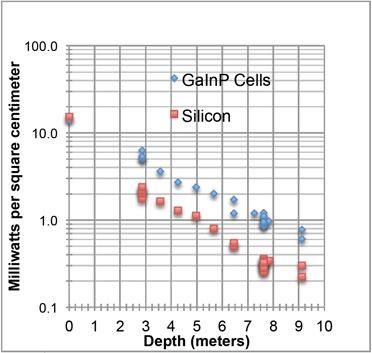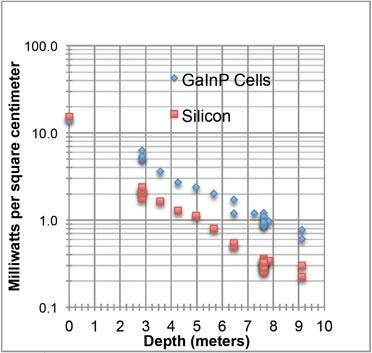Solar Cells Power Underwater Sensors
June 12, 2012

The Navy is exploring the use of solar cells to power sensors underwater as part of research across the US military to develop alternative, environmentally friendly, and efficient sources of energy.
Scientists at the US Naval Research Lab's (NRL) Electronics Science and Technology Division have had success using underwater photovoltaic research to develop solar cells that can operate electronic sensors at depths of up to 9m, or about 30ft. Photovoltaics involves generating electrical power by converting solar radiation into direct current electricity.
The research came about due to the need for long-endurance power sources to fuel underwater autonomous systems and sensors. They currently rely on power sources onshore, batteries, or solar power supplied by a source above the water, but these are limiting and inefficient, according to the NRL.

The task of using solar energy underwater was not without its challenges, however. Scientists had explored the use of photovoltaics before, but with solar cells that were optimized for the terrestrial solar spectrum. Therefore, these systems had only limited power because of the lack of sunlight that reached them underwater. To solve that problem, scientists designed the solar cells using different materials to match the wavelength range of the less-intense solar radiation underwater.
Previous solar cells were based on crystalline silicon or amorphous silicon, which are well matched to the wavelength of terrestrial sunlight. To take advantage of solar energy in low-light conditions, however, scientists switched their focus to the design of high-quality gallium indium phosphide (GaInP), a higher bandgap material that performs better in low-light conditions.
The filtered spectrum of sun underwater uses the blue/green portion of the light spectrum more than any other, researchers found. GaInP has high quantum efficiency in wavelengths between 400 nanometers and 700 nanometers and intrinsically low dark current, a spectrum that allows it to perform much more efficiently.
By creating solar cells using GaInP, researchers have been able to generate 7W per square meter with solar cells at a maximum depth of 9.1m, or about 30ft. This performance shows that the cells can be used to power sensor systems at typical depths close to shorelines, according to the NRL.
The Navy is not the only military branch exploring the use of alternative energy to provide more cost-effective and environmentally-friendly power sources. The Army also is leveraging solar power, specifically in portable renewable energy microgrids that use both the sun and wind to generate electricity.
Related posts:
About the Author(s)
You May Also Like

.jpg?width=300&auto=webp&quality=80&disable=upscale)

